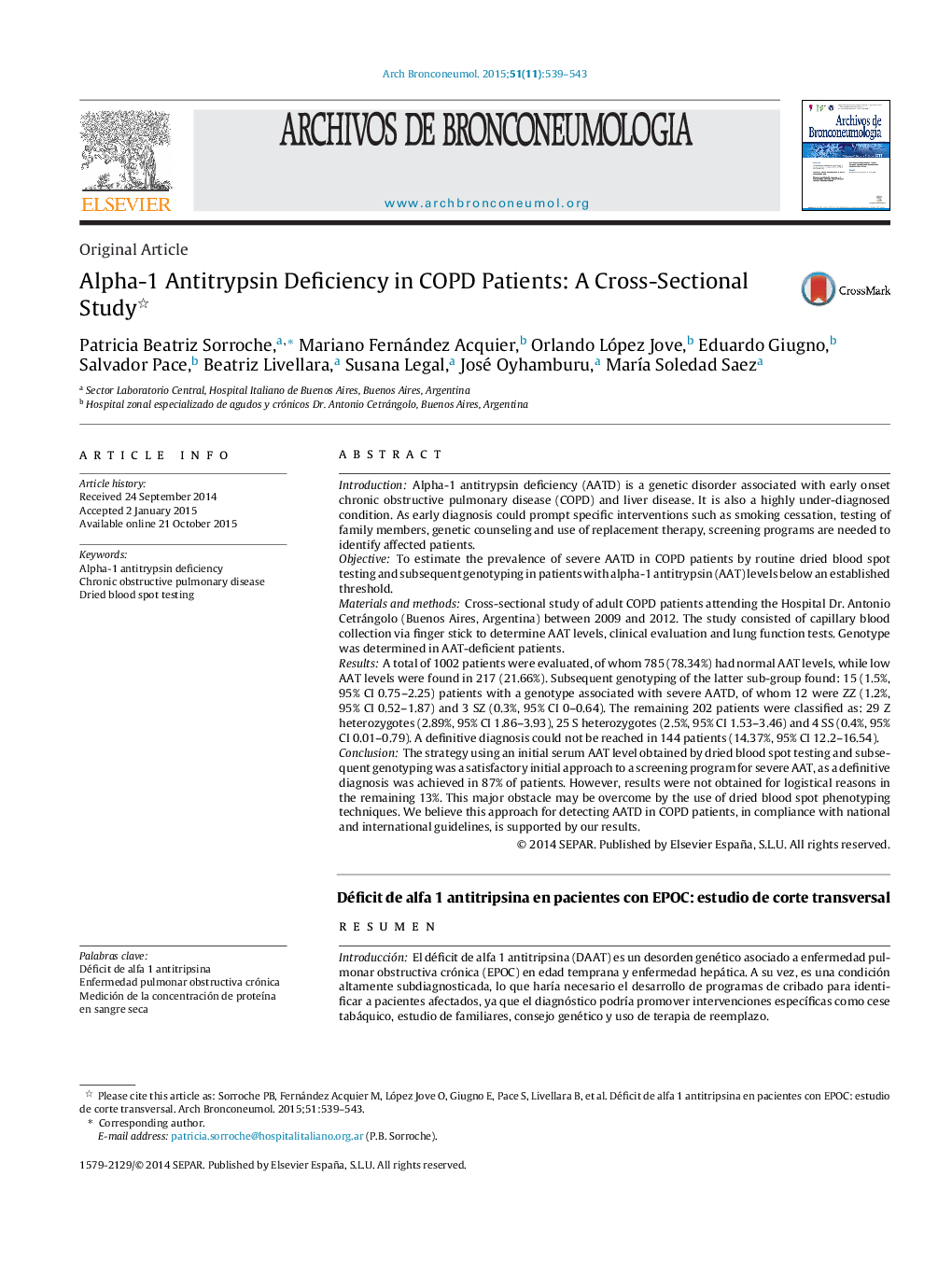| کد مقاله | کد نشریه | سال انتشار | مقاله انگلیسی | نسخه تمام متن |
|---|---|---|---|---|
| 4205418 | 1279909 | 2015 | 5 صفحه PDF | دانلود رایگان |

IntroductionAlpha-1 antitrypsin deficiency (AATD) is a genetic disorder associated with early onset chronic obstructive pulmonary disease (COPD) and liver disease. It is also a highly under-diagnosed condition. As early diagnosis could prompt specific interventions such as smoking cessation, testing of family members, genetic counseling and use of replacement therapy, screening programs are needed to identify affected patients.ObjectiveTo estimate the prevalence of severe AATD in COPD patients by routine dried blood spot testing and subsequent genotyping in patients with alpha-1 antitrypsin (AAT) levels below an established threshold.Materials and methodsCross-sectional study of adult COPD patients attending the Hospital Dr. Antonio Cetrángolo (Buenos Aires, Argentina) between 2009 and 2012. The study consisted of capillary blood collection via finger stick to determine AAT levels, clinical evaluation and lung function tests. Genotype was determined in AAT-deficient patients.ResultsA total of 1002 patients were evaluated, of whom 785 (78.34%) had normal AAT levels, while low AAT levels were found in 217 (21.66%). Subsequent genotyping of the latter sub-group found: 15 (1.5%, 95% CI 0.75–2.25) patients with a genotype associated with severe AATD, of whom 12 were ZZ (1.2%, 95% CI 0.52–1.87) and 3 SZ (0.3%, 95% CI 0–0.64). The remaining 202 patients were classified as: 29 Z heterozygotes (2.89%, 95% CI 1.86–3.93), 25 S heterozygotes (2.5%, 95% CI 1.53–3.46) and 4 SS (0.4%, 95% CI 0.01–0.79). A definitive diagnosis could not be reached in 144 patients (14.37%, 95% CI 12.2–16.54).ConclusionThe strategy using an initial serum AAT level obtained by dried blood spot testing and subsequent genotyping was a satisfactory initial approach to a screening program for severe AAT, as a definitive diagnosis was achieved in 87% of patients. However, results were not obtained for logistical reasons in the remaining 13%. This major obstacle may be overcome by the use of dried blood spot phenotyping techniques. We believe this approach for detecting AATD in COPD patients, in compliance with national and international guidelines, is supported by our results.
ResumenIntroducciónEl déficit de alfa 1 antitripsina (DAAT) es un desorden genético asociado a enfermedad pulmonar obstructiva crónica (EPOC) en edad temprana y enfermedad hepática. A su vez, es una condición altamente subdiagnosticada, lo que haría necesario el desarrollo de programas de cribado para identificar a pacientes afectados, ya que el diagnóstico podría promover intervenciones específicas como cese tabáquico, estudio de familiares, consejo genético y uso de terapia de reemplazo.ObjetivoEstimar la prevalencia de DAAT grave en pacientes con EPOC mediante la cuantificación de la proteína en sangre seca de forma rutinaria y posterior genotipado de aquellos pacientes con concentraciones por debajo de un umbral establecido.Materiales y métodosEstudio de corte transversal de pacientes adultos con diagnóstico de EPOC que consultaron al Hospital Dr. Antonio Cetrángolo (Buenos Aires, Argentina) entre 2009 y 2012. La participación en el estudio consistió en la toma de una muestra de sangre por punción capilar del pulpejo del dedo para la determinación de las concentraciones de alfa 1 antitripsina (AAT), evaluación clínica y evaluación de función pulmonar. En los pacientes con déficit, se determinó adicionalmente el genotipo.ResultadosUn total de 1.002 pacientes fueron evaluados, de los cuales 785 (78,34%) tuvieron un valor normal de AAT, mientras que en 217 (21,66%) se detectó un déficit de concentración de AAT; a este último subgrupo se les realizó genotipado posterior, que arrojó: 15 (1,5%, IC 95% 0,75-2,25) pacientes con genotipo asociado a DAAT grave, de los cuales 12 ZZ (1,2%, IC 95% 0,52-1,87) y 3 SZ (0,3%, IC 95% 0-0,64). Los 202 pacientes restantes se clasificaron como: 29 heterocigotos Z (2,89%, IC 95% 1,86-3,93), 25 heterocigotos S (2,5%, IC 95% 1,53-3,46) y 4 SS (0,4%, IC 95% 0,01-0,79). Por otra parte, en 144 pacientes (14,37%, IC 95% 12,2-16,54) no se llegó a un diagnóstico definitivo.ConclusiónLa estrategia utilizada con concentración sérica inicial de AAT según la proteína en sangre seca y posterior genotipado resultó adecuada como primera aproximación a un programa de cribado de DAAT grave, ya que se logró el diagnóstico definitivo en un 87% de los pacientes. Sin embargo, no se obtuvieron resultados por razones logísticas en el 13% restante. La implementación de técnicas para fenotipado en proteína en sangre seca permitirá corregir este significativo problema en esta etapa. Creemos que los resultados obtenidos avalarían su aplicación para la detección DAAT en poblaciones de pacientes con EPOC en cumplimiento de las recomendaciones de las guías nacionales e internacionales.
Journal: Archivos de Bronconeumología (English Edition) - Volume 51, Issue 11, November 2015, Pages 539–543